fuel YAMAHA XV1900A 2012 Owners Manual
[x] Cancel search | Manufacturer: YAMAHA, Model Year: 2012, Model line: XV1900A, Model: YAMAHA XV1900A 2012Pages: 88, PDF Size: 1.91 MB
Page 6 of 88

TABLE OF CONTENTSSAFETY INFORMATION ..................1-1
DESCRIPTION ..................................2-1
Left view ..........................................2-1
Right view ........................................2-2
Controls and instrume nts.................2-3
INSTRUMENT AND CONTROL
FUNCTIONS .......................................3-1
Immobilizer system .... .....................3-1
Main switch/steering lock ................3-2
Indicator lights and warning lights ............................................3-4
Multi-function meter unit .................3-5
Anti-theft alarm (optional) .............3-10
Handlebar switches ......................3-10
Clutch lever ...................................3-12
Shift pedal .... ............................ .....3-12
Brake lever ...................................3-12
Brake pedal ..................................3-13
Fuel tank cap ................................3-13
Fuel ...............................................3-14
Fuel tank breather/overflow
hose ..........................................3-15
Catalytic converter ........................3-15
Rider seat .....................................3-16
Helmet holder ...............................3-17
Adjusting the shock absorber
assembly ...................................3-18
EXUP system ...............................3-19
Sidestand ......................................3-20 Ignition circuit cut-
off system ........ 3-20
Auxiliary DC connector ................. 3-22
FOR YOUR SAFETY –
PRE-OPERATION CHECKS ............. 4-1
OPERATION AND IMPORTANT
RIDING POINTS ................................. 5-1
Starting the engine ......................... 5-1
Shifting ........................................... 5-2
Tips for reducing fuel consumption ............................... 5-3
Engine break-in .............................. 5-3
Parking ........................................... 5-4
PERIODIC MAINTENANCE AND
ADJUSTMENT ................................... 6-1
Owner’s tool kit ............................... 6-2
Periodic maintenance chart for the emission control system ............. 6-3
General maintenance and lubrication chart .......................... 6-4
Checking the spark plugs ............... 6-8
Engine oil and oil filter cartridge ..... 6-9
Transfer case oil ........................... 6-12
Air filter element ........................... 6-12
Checking the throttle grip free play ........................................... 6-13
Valve clearance ............................ 6-13
Tires ............................................. 6-13
Cast wheels .................................. 6-15 Clutch lever .................................. 6-15
Checking the brake lever free
play ........................................... 6-16
Brake light switches ..................... 6-16
Checking the front and rear brake
pads .......................................... 6-17
Checking the brake and clutch fluid levels ................................. 6-17
Changing the brake and clutch fluids ......................................... 6-19
Drive belt slack ............................ 6-19
Checking and lubricating the cables ....................................... 6-20
Checking and lubricating the
throttle grip and cable ............... 6-20
Checking and lubricating the brake and shift pedals .............. 6-21
Checking and lubricating the brake and clutch levers ............ 6-21
Checking and lubricating the
sidestand .................................. 6-22
Lubricating the rear suspension ... 6-22
Checking the front fork ................. 6-23
Checking the steering .................. 6-23
Checking the wheel bearings ....... 6-24
Battery ......................................... 6-24
Replacing the fuses ..................... 6-25
Replacing a headlight bulb .......... 6-26
Tail/brake light ............................. 6-29
Replacing a turn signal light bulb ........................................... 6-29U1CRE1E0.book Page 1 Mond ay, October 3, 2011 8:45 AM
Page 12 of 88

SAFETY INFORMATION
1-5
1
●
Check that the fuel cock (if
equipped) is in the “OFF” position
and that there are no fuel leaks.
●
Point the front wheel straight
ahead on the trailer or in the truck
bed, and choke it in a rail to pre-
vent movement.
●
Shift the transmission in gear (for
models with a manual transmis-
sion).
●
Secure the motorcycle with tie-
downs or suitable straps that are
attached to solid parts of the mo-
torcycle, such as the frame or up-
per front fork triple clamp (and not,
for example, to rubber-mounted
handlebars or turn signals, or parts
that could break). Choose the lo-
cation for the straps carefully so
the straps will not rub against
painted surfaces during transport.
●
The suspension should be com-
pressed somewhat by the tie-
downs, if possible, so that the mo-
torcycle will not bounce excessive-
ly during transport.
U1CRE1E0.book Page 5 Monday, October 3, 2011 8:45 AM
Page 14 of 88
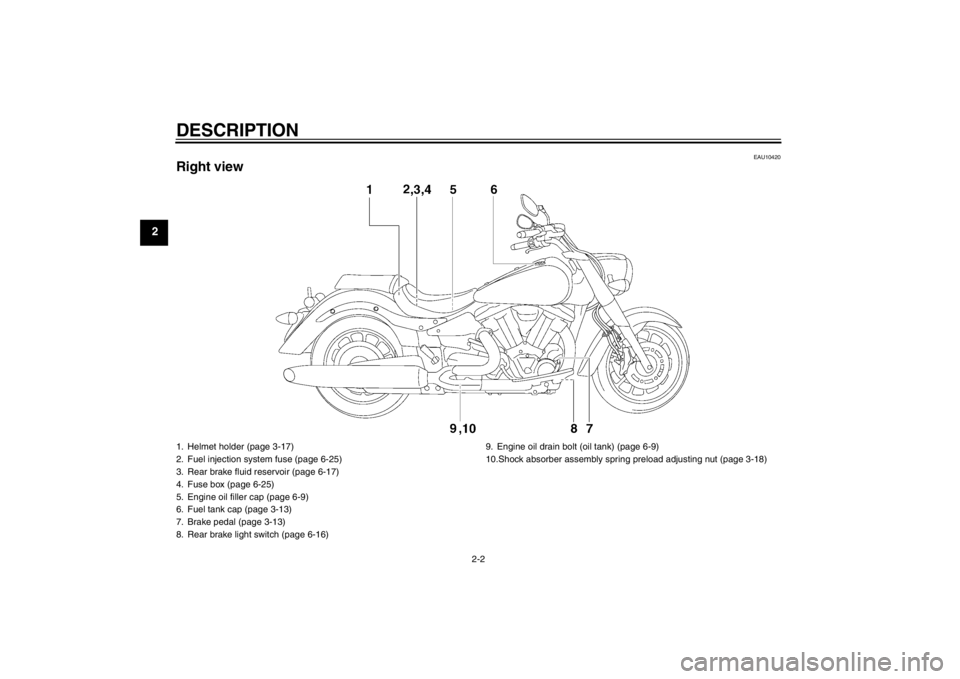
DESCRIPTION
2-2
2
EAU10420
Right view1. Helmet holder (page 3-17)
2. Fuel injection system fuse (page 6-25)
3. Rear brake fluid reservoir (page 6-17)
4. Fuse box (page 6-25)
5. Engine oil filler cap (page 6-9)
6. Fuel tank cap (page 3-13)
7. Brake pedal (page 3-13)
8. Rear brake light switch (page 6-16)9. Engine oil drain bolt
(oil tank) (page 6-9)
10.Shock absorber assembly spring preload adjusting nut (page 3-18)U1CRE1E0.book Page 2 Monday, October 3, 2011 8:45 AM
Page 19 of 88
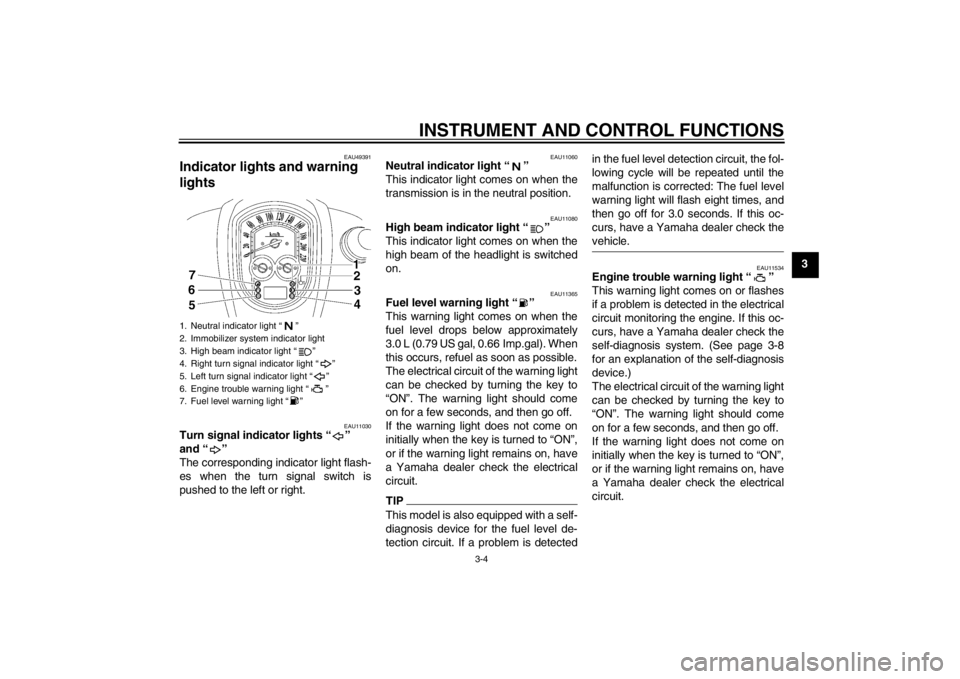
INSTRUMENT AND CONTROL FUNCTIONS
3-4
3
EAU49391
Indicator lights and warning
lights
EAU11030
Turn signal indicator lights “ ”
and “ ”
The corresponding indicator light flash-
es when the turn signal switch is
pushed to the left or right.
EAU11060
Neutral indicator light “ ”
This indicator light comes on when the
transmission is in the neutral position.
EAU11080
High beam indicator light “ ”
This indicator light comes on when the
high beam of the headlight is switched
on.
EAU11365
Fuel level warning light “ ”
This warning light comes on when the
fuel level drops below approximately
3.0 L (0.79 US gal, 0.66 Imp.gal). When
this occurs, refuel as soon as possible.
The electrical circuit of the warning light
can be checked by turning the key to
“ON”. The warning light should come
on for a few seconds, and then go off.
If the warning light does not come on
initially when the key is turned to “ON”,
or if the warning light remains on, have
a Yamaha dealer check the electrical
circuit.TIPThis model is also equipped with a self-
diagnosis device for the fuel level de-
tection circuit. If a problem is detected in the fuel level detection circuit, the fol-
lowing cycle will be repeated until the
malfunction is corrected: The fuel level
warning light will flash eight times, and
then go off for 3.0 seconds. If this oc-
curs, have a Yamaha dealer check the
vehicle.
EAU11534
Engine trouble warning light “ ”
This warning light comes on or flashes
if a problem is detected in the electrical
circuit monitoring the engine. If this oc-
curs, have a Yamaha dealer check the
self-diagnosis system. (See page 3-8
for an explanation of the self-diagnosis
device.)
The electrical circuit of the warning light
can be checked by turning the key to
“ON”. The warning light should come
on for a few seconds, and then go off.
If the warning light does not come on
initially when the key is turned to “ON”,
or if the warning light remains on, have
a Yamaha dealer check the electrical
circuit.
1. Neutral indicator light “ ”
2. Immobilizer system indicator light
3. High beam indicator light “ ”
4. Right turn signal indicator light “ ”
5. Left turn signal indicator light “ ”
6. Engine trouble warning light “ ”
7. Fuel level warning light “ ”
U1CRE1E0.book Page 4 Mond
ay, October 3, 2011 8:45 AM
Page 20 of 88
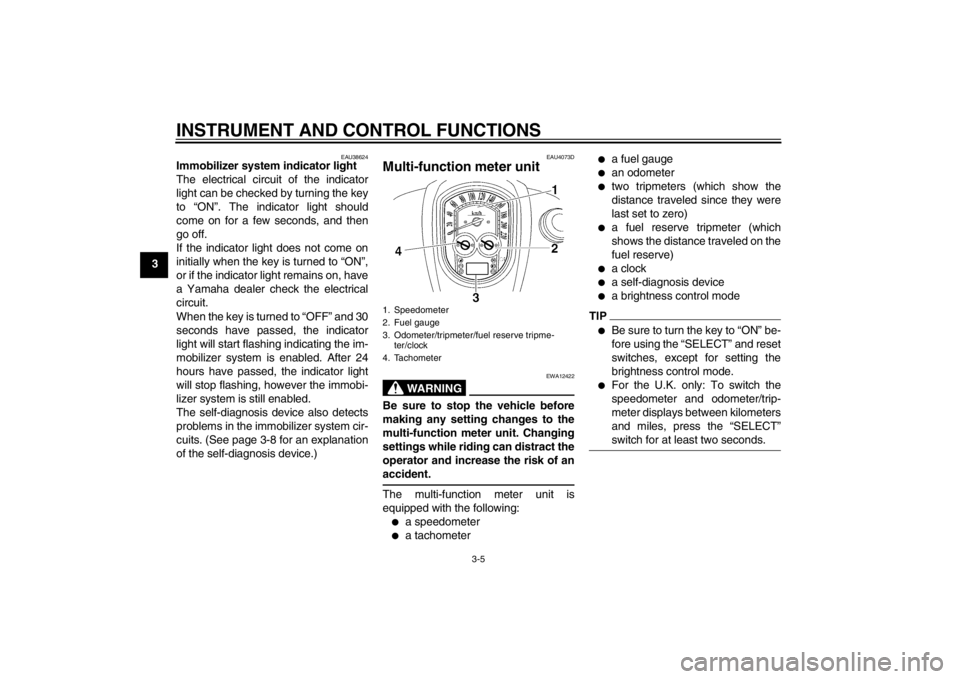
INSTRUMENT AND CONTROL FUNCTIONS
3-5
3
EAU38624
Immobilizer system indicator light
The electrical circuit of the indicator
light can be checked by turning the key
to “ON”. The indicator light should
come on for a few seconds, and then
go off.
If the indicator light does not come on
initially when the key is turned to “ON”,
or if the indicator light remains on, have
a Yamaha dealer check the electrical
circuit.
When the key is turned to “OFF” and 30
seconds have passed, the indicator
light will start flashing indicating the im-
mobilizer system is enabled. After 24
hours have passed, the indicator light
will stop flashing, however the immobi-
lizer system is still enabled.
The self-diagnosis device also detects
problems in the immobilizer system cir-
cuits. (See page 3-8 for an explanation
of the self-diagnosis device.)
EAU4073D
Multi-function meter unit
WARNING
EWA12422
Be sure to stop the vehicle before
making any setting changes to the
multi-function meter unit. Changing
settings while riding can distract the
operator and increase the risk of an
accident.The multi-function meter unit is
equipped with the following:●
a speedometer
●
a tachometer
●
a fuel gauge
●
an odometer
●
two tripmeters (which show the
distance traveled since they were
last set to zero)
●
a fuel reserve tripmeter (which
shows the distance traveled on the
fuel reserve)
●
a clock
●
a self-diagnosis device
●
a brightness control mode
TIP●
Be sure to turn the key to “ON” be-
fore using the “SELECT” and reset
switches, except for setting the
brightness control mode.
●
For the U.K. only: To switch the
speedometer and odometer/trip-
meter displays between kilometers
and miles, press the “SELECT”
switch for at least two seconds.
1. Speedometer
2. Fuel gauge
3. Odometer/tripmeter/fuel reserve tripme-ter/clock
4. Tachometer
U1CRE1E0.book Page 5 Mond ay, October 3, 2011 8:45 AM
Page 22 of 88
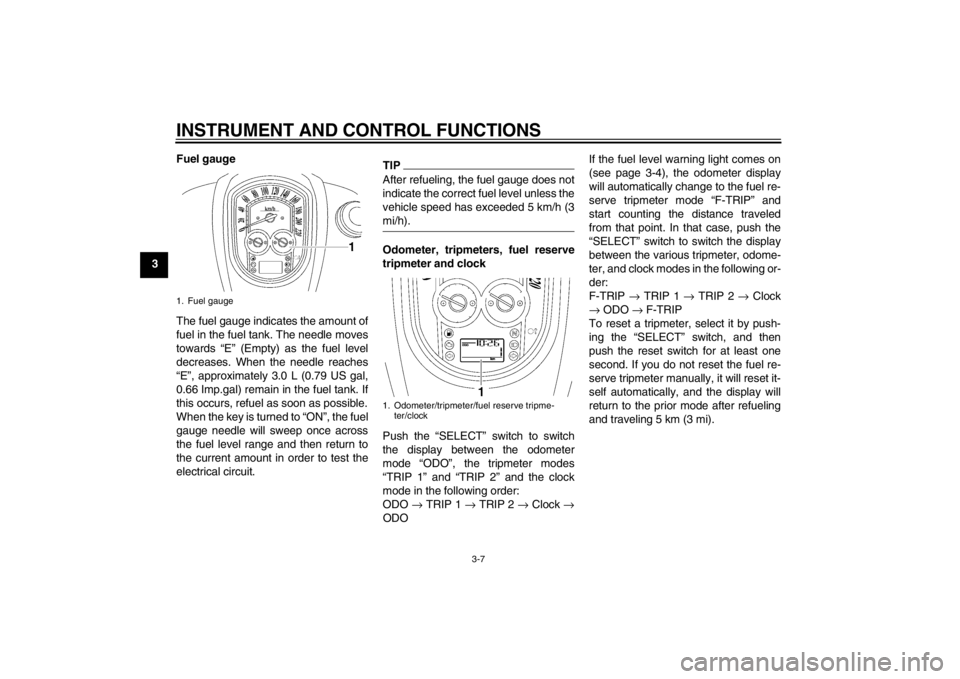
INSTRUMENT AND CONTROL FUNCTIONS
3-7
3Fuel gauge
The fuel gauge indicates the amount of
fuel in the fuel tank. The needle moves
towards “E” (Empty) as the fuel level
decreases. When the needle reaches
“E”, approximately 3.0 L (0.79 US gal,
0.66 Imp.gal) remain in the fuel tank. If
this occurs, refuel as soon as possible.
When the key is turned to “ON”, the fuel
gauge needle will sweep once across
the fuel level range and then return to
the current amount in order to test the
electrical circuit.
TIPAfter refueling, the fuel gauge does not
indicate the correct fuel level unless the
vehicle speed has exceeded 5 km/h (3
mi/h).Odometer, tripmeters, fuel reserve
tripmeter and clock
Push the “SELECT” switch to switch
the display between the odometer
mode “ODO”, the tripmeter modes
“TRIP 1” and “TRIP 2” and the clock
mode in the following order:
ODO
→ TRIP 1 → TRIP 2 → Clock →
ODO If the fuel level warning light comes on
(see page 3-4), the odometer display
will automatically change to the fuel re-
serve tripmeter mode “F-TRIP” and
start counting the distance traveled
from that point. In that case, push the
“SELECT” switch to switch the display
between the various tripmeter, odome-
ter, and clock modes in the following or-
der:
F-TRIP
→ TRIP 1 → TRIP 2 → Clock
→ ODO → F-TRIP
To reset a tripmeter, select it by push-
ing the “SELECT” switch, and then
push the reset switch for at least one
second. If you do not reset the fuel re-
serve tripmeter manually, it will reset it-
self automatically, and the display will
return to the prior mode after refueling
and traveling 5 km (3 mi).
1. Fuel gauge
1. Odometer/tripmeter/fuel reserve tripme- ter/clock
U1CRE1E0.book Page 7 Mond ay, October 3, 2011 8:45 AM
Page 24 of 88
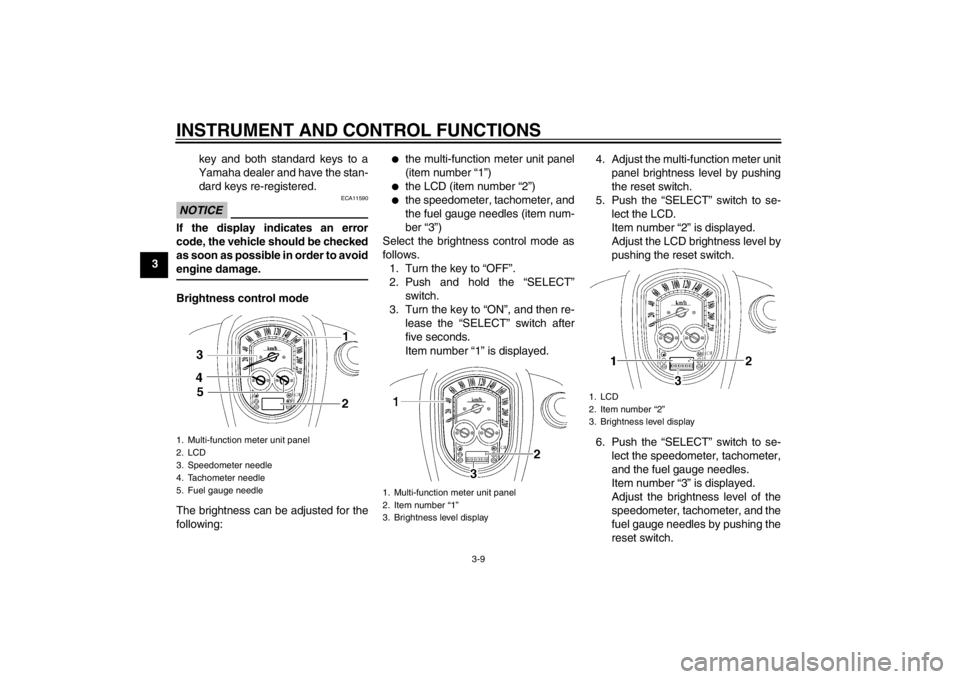
INSTRUMENT AND CONTROL FUNCTIONS
3-9
3key and both standard keys to a
Yamaha dealer and have the stan- dard keys re-registered.
NOTICE
ECA11590
If the display indicates an error
code, the vehicle should be checked
as soon as possible in order to avoid
engine damage.Brightness control mode
The brightness can be adjusted for the
following:
●
the multi-function meter unit panel
(item number “1”)
●
the LCD (item number “2”)
●
the speedometer, tachometer, and
the fuel gauge needles (item num-
ber “3”)
Select the brightness control mode as
follows. 1. Turn the key to “OFF”.
2. Push and hold the “SELECT” switch.
3. Turn the key to “ON”, and then re- lease the “SELECT” switch after
five seconds.
Item number “1” is displayed. 4. Adjust the multi-function meter unit
panel brightness level by pushing
the reset switch.
5. Push the “SELECT” switch to se- lect the LCD.
Item number “2” is displayed.
Adjust the LCD brightness level by
pushing the reset switch.
6. Push the “SELECT” switch to se- lect the speedometer, tachometer,
and the fuel gauge needles.
Item number “3” is displayed.
Adjust the brightness level of the
speedometer, tachometer, and the
fuel gauge needles by pushing the
reset switch.
1. Multi-function meter unit panel
2. LCD
3. Speedometer needle
4. Tachometer needle
5. Fuel gauge needle
1. Multi-function meter unit panel
2. Item number “1”
3. Brightness level display
1. LCD
2. Item number “2”
3. Brightness level display
U1CRE1E0.book Page 9 Mond ay, October 3, 2011 8:45 AM
Page 25 of 88
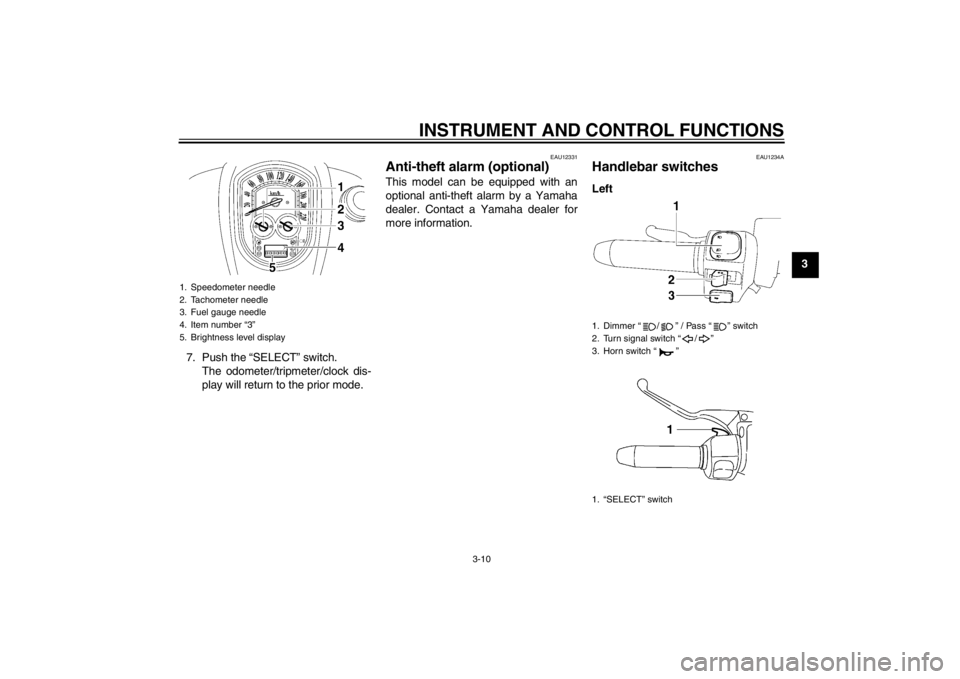
INSTRUMENT AND CONTROL FUNCTIONS
3-10
3
7. Push the “SELECT” switch. The odometer/tripmeter/clock dis-
play will return to the prior mode.
EAU12331
Anti-theft alarm (optional) This model can be equipped with an
optional anti-theft alarm by a Yamaha
dealer. Contact a Yamaha dealer for
more information.
EAU1234A
Handlebar switches Left
1. Speedometer needle
2. Tachometer needle
3. Fuel gauge needle
4. Item number “3”
5. Brightness level display
1. Dimmer “ / ” / Pass “ ” switch
2. Turn signal switch “ / ”
3. Horn switch “ ”
1. “SELECT” switch
U1CRE1E0.book Page 10 Monday, October 3, 2011 8:45 AM
Page 28 of 88
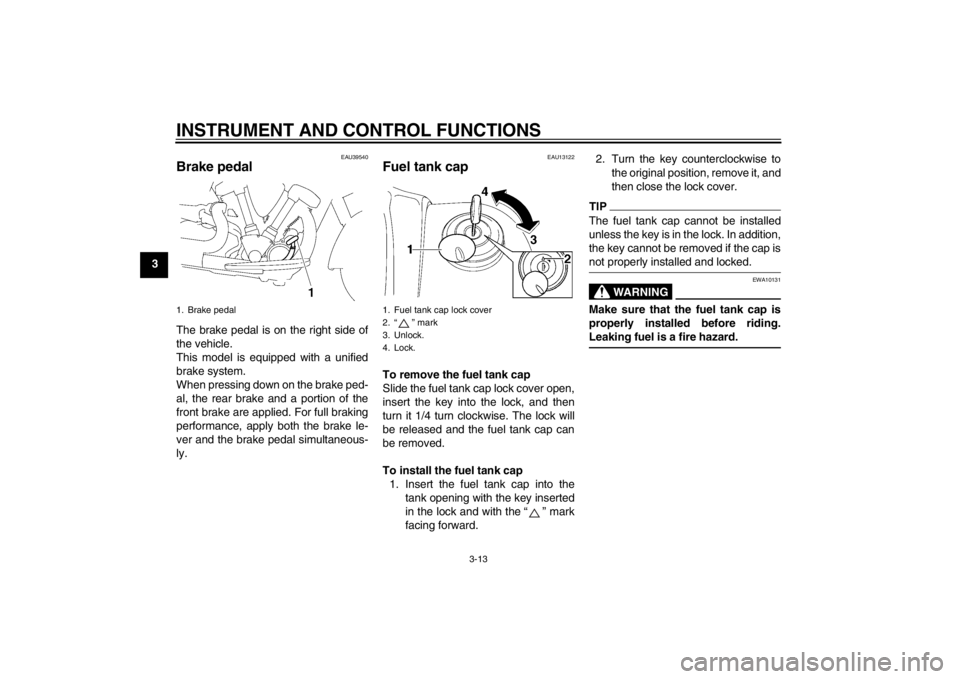
INSTRUMENT AND CONTROL FUNCTIONS
3-13
3
EAU39540
Brake pedal The brake pedal is on the right side of
the vehicle.
This model is equipped with a unified
brake system.
When pressing down on the brake ped-
al, the rear brake and a portion of the
front brake are applied. For full braking
performance, apply both the brake le-
ver and the brake pedal simultaneous-
ly.
EAU13122
Fuel tank cap To remove the fuel tank cap
Slide the fuel tank cap lock cover open,
insert the key into the lock, and then
turn it 1/4 turn clockwise. The lock will
be released and the fuel tank cap can
be removed.
To install the fuel tank cap1. Insert the fuel tank cap into the tank opening with the key inserted
in the lock and with the “ ” mark
facing forward. 2. Turn the key counterclockwise to
the original position, remove it, and
then close the lock cover.
TIPThe fuel tank cap cannot be installed
unless the key is in the lock. In addition,
the key cannot be removed if the cap is
not properly installed and locked.
WARNING
EWA10131
Make sure that the fuel tank cap is
properly installed before riding.
Leaking fuel is a fire hazard.
1. Brake pedal
1. Fuel tank cap lock cover
2. “ ” mark
3. Unlock.
4. Lock.
U1CRE1E0.book Page 13 Monday, October 3, 2011 8:45 AM
Page 29 of 88
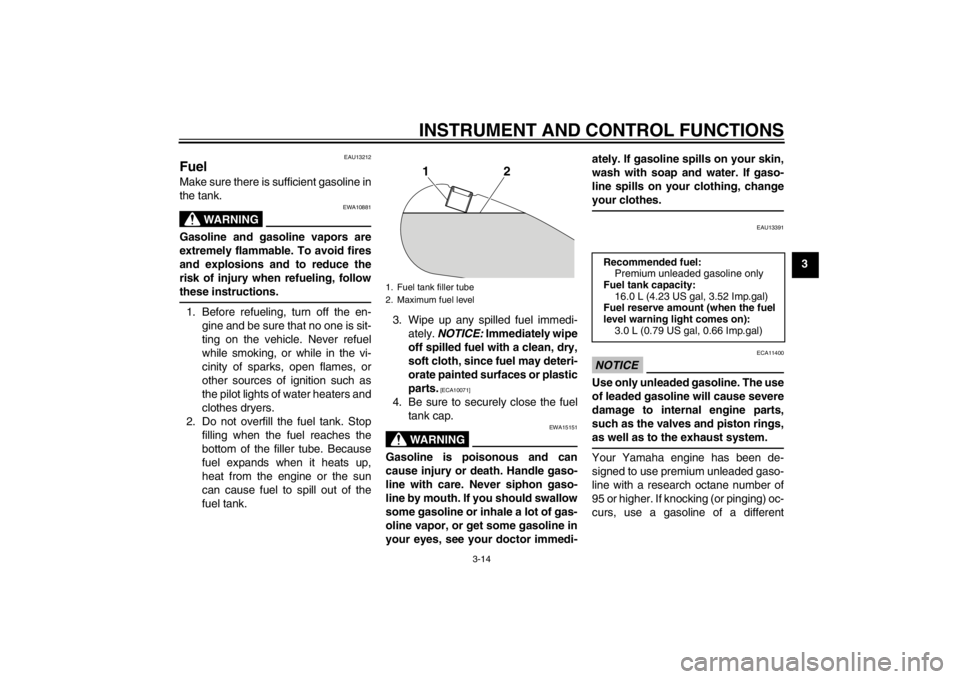
INSTRUMENT AND CONTROL FUNCTIONS
3-14
3
EAU13212
Fuel Make sure there is sufficient gasoline in
the tank.
WARNING
EWA10881
Gasoline and gasoline vapors are
extremely flammable. To avoid fires
and explosions and to reduce the
risk of injury when refueling, follow
these instructions.1. Before refueling, turn off the en-gine and be sure that no one is sit-
ting on the vehicle. Never refuel
while smoking, or while in the vi-
cinity of sparks, open flames, or
other sources of ignition such as
the pilot lights of water heaters and
clothes dryers.
2. Do not overfill the fuel tank. Stop filling when the fuel reaches the
bottom of the filler tube. Because
fuel expands when it heats up,
heat from the engine or the sun
can cause fuel to spill out of the
fuel tank. 3. Wipe up any spilled fuel immedi-
ately. NOTICE: Immediately wipe
off spilled fuel with a clean, dry,
soft cloth, since fuel may deteri-
orate painted surfaces or plastic
parts.
[ECA10071]
4. Be sure to securely close the fuel tank cap.
WARNING
EWA15151
Gasoline is poisonous and can
cause injury or death. Handle gaso-
line with care. Never siphon gaso-
line by mouth. If you should swallow
some gasoline or inhale a lot of gas-
oline vapor, or get some gasoline in
your eyes, see your doctor immedi- ately. If gasoline spills on your skin,
wash with soap and water. If gaso-
line spills on your clothing, change
your clothes.
EAU13391
NOTICE
ECA11400
Use only unleaded gasoline. The use
of leaded gasoline will cause severe
damage to internal engine parts,
such as the valves and piston rings,
as well as to the exhaust system.Your Yamaha engine has been de-
signed to use premium unleaded gaso-
line with a research octane number of
95 or higher. If knocking (or pinging) oc-
curs, use a gasoline of a different
1. Fuel tank filler tube
2. Maximum fuel level
2
1
Recommended fuel:
Premium unleaded gasoline only
Fuel tank capacity: 16.0 L (4.23 US gal, 3.52 Imp.gal)
Fuel reserve amount (when the fuel
level warning light comes on):
3.0 L (0.79 US gal, 0.66 Imp.gal)
U1CRE1E0.book Page 14 Monday, October 3, 2011 8:45 AM